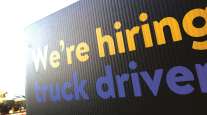Staff Reporter
Driver Financial Security Key to Recruitment, Retention

[Stay on top of transportation news: Get TTNews in your inbox.]
Truck driver recruitment and retention have been difficult this year, but providing financial security can be a huge incentive.
“There’s been a lot of carriers that have looked at different pay models, bonus models and incentive pay, so we were really interested in seeing what the drivers thought,” Scott Dismuke, director of operations at Professional Driver Agency, told Transport Topics. “What we hear from drivers on a daily basis is really about predictability, and the predictability of pay for their own security and for that of their families.”
Professional Driver Agency and Conversion Interactive Agency released a survey on recruitment and retention Dec. 1 that had 1,197 respondents. It found drivers overwhelmingly (81.1%) prefer a guaranteed pay model, 25.4% prefer a pay-per mile model and only 13.4% prefer incentive-based pay. Respondents were allowed to choose more than one preference.
The challenges presented in 2020 have left carriers questioning what truck drivers want and examining whether their offerings fit the bill. Download our newest whitepaper to find out what drivers really think about pay, job searching, and much more! https://t.co/akP2IfGuc9 pic.twitter.com/kILUfGri08 — Conversion Interactive Agency (@ConversionIA) December 1, 2020
“Whether they use a pay-per-mile model or guaranteed pay model or if they incorporate sign-on bonuses, I think that the key is they have to deliver on the expectations that the driver has,” Priscilla Peters, Conversion Interactive Agency vice president of marketing, told TT. “So they have to deliver on what they’re selling.”
Dismuke noted guaranteed pay being a huge takeaway didn’t surprise him. That sort of security always has been a desire of drivers, but it was amplified this year with the uncertainty that came from the coronavirus and the economic shutdowns.
“I know a lot of carriers are having trouble finding drivers right now,” Dismuke said. “Schools are shutting down for the most part, and you don’t have a lot of new drivers entering the market. So keeping drivers you have right now, in particular, has become super important.”

Peters
The survey also found sign-on bonuses weren’t a big incentive for drivers. The majority (42%) said it is “a great perk” but not a determining factor.
Home time also is important with 50.8% of drivers believing equipment issues impacts it.
“From a recruiting standpoint, increased competition and drivers choosing opportunities with better home time [are challenges we’re facing],” Jacob Kramer, vice president of driver recruiting at U.S. Xpress Enterprises, told TT. “Retention-wise, carriers across the board are increasing pay, so we’re seeing more drivers jump to a higher rate. The industrywide driver shortage has exacerbated both challenges.”
At the heart of the issue is the limited pool of available drivers. Training programs have closed or are adhering to safety protocols such as social distancing. Also, there has been high volume demand in certain segments.
“Due to the COVID restrictions, social distancing and DMV shutdowns, we have significantly fewer new drivers,” American Trucking Associations Chief Economist Bob Costello told TT. “Even if things changed now, which they’re not, obviously, because we’re going the other way, but even if they did, that’s a hole that’s going to take a long time to dig out of.”
He added that the result is the number of new drivers has significantly decreased. That, on top of demand, means competition for drivers is intense so fleets are increasing pay or promising sign-on bonuses.
How did turkey-to-table change this year? What obstacles were suppliers going through to get turkeys to grocery stores? Join us as we talk with J.J. Smith, President of Valley Proteins, about how staying open-minded and flexible helped his business of delivering turkeys persevere. Hear a snippet, above, and get the full program by going to RoadSigns.TTNews.com.
“I would contend that earlier on in the year what we saw was unease,” John Bozec, Schneider senior vice president and general manager of van truckload and dedicated, told TT. “Then as the year unfolded, we started seeing things like driver schools close permanently or on a temporary basis.”
He noted since it’s difficult to get new drivers, the best strategy is to retain them by ensuring they have good equipment and sufficient work. Schneider also has deployed technology to make work easier for drivers.
“All of that combined together is designed to retain our existing drivers,” Bozec said. “Pay always matters. Pay matters to us. It matters for really everyone. But it has to be everything. To attract new drivers, we have to continue to tell the story of why this is a great industry.”
Schneider ranks No. 5 on the Transport Topics Top 100 list of the largest for-hire carriers in North America and No. 18 on the TT Top 50 list of the largest logistics companies.
Trucking firms also have to be attentive to their drivers’ needs. Dismuke noted equipment issues such as a truck in the shop can lead to other problems, including logging fewer miles or missing home time.

Dismuke
“It’s so important from a retention standpoint to know the drivers that are having issues so you can go in and address those,” Dismuke said. “Because if you don’t, they’re going to be gone.”
Kramer noted from a broader industry view that carriers will have to get strategic with their recruiting. He added companies also must be flexible and meet the drivers on their time.
U.S. Xpress has utilized technology to better target and communicate with drivers.
“Even during this challenging time, we’re surpassing our recruiting goals week-over-week compared to 2019,” Kramer said. “We’re doing that through improved technology and innovative media strategies, including artificial intelligence, to recruit new drivers. Our approach is to meet drivers where they are.”
U.S. Xpress ranks No. 24 on the for-hire TT100.
Want more news? Listen to today's daily briefing:
Subscribe: Apple Podcasts | Spotify | Amazon Alexa | Google Assistant | More





